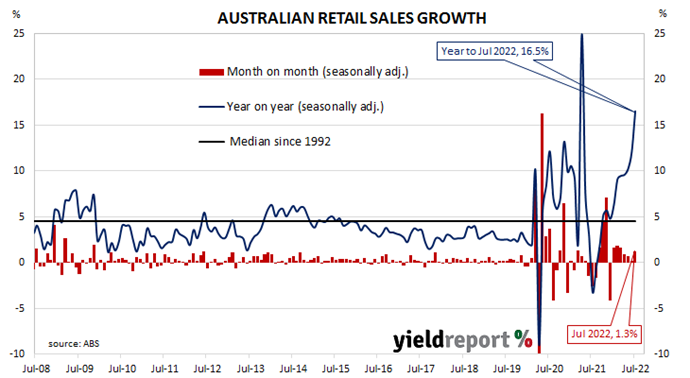Summary: Retail sales up 1.3% in July, higher than expected; “broad-based lift” not a “rogue” event; rising prices account for sizable portion of total increase; net overseas arrivals very positive in July; tourism, returning residents “likely key driver”; largest influence on month from food sales.
Growth figures of domestic retail sales spent most of the 2010s at levels below the post-1992 average. While economic conditions had been generally favourable, wage growth and inflation rates were low. Expenditures on goods then jumped in the early stages of 2020 as government restrictions severely altered households’ spending habits. Households mostly reverted to their usual patterns as restrictions eased in the latter part of 2020 and throughout 2021, although not for all categories.
According to the latest ABS figures, total retail sales increased by 1.3% in July on a seasonally adjusted basis. The rise was noticeably greater than the 0.3% increase which had been expected as well as June’s 0.2% increase. On an annual basis, retail sales increased by 16.5%, up from June’s comparable figure of 12.0%.
“The detail shows a broad-based lift with nothing to suggest the monthly gain is a ‘rogue’ ,” said Westpac senior economist Matthew Hassan. “That said, rising retail prices undoubtedly account for a sizeable part of the rise, with volumes likely to have been somewhat flatter.”
Commonwealth bond yields increased on the day, especially at the short end. By the close of business, the 3-year ACGB yield had jumped 15bps to 3.43%, the 10-year rate had gained 9bps to 3.68% while the 20-year yield finished 4bps higher at 3.95%.
ANZ senior economist Adelaide Timbrell took a somewhat different approach to her Westpac counterpart, pointing to increased arrivals at Australian airports and ports. “Net overseas arrivals were very positive in July, signalling that tourism and returning residents were likely a key driver of the bump in retail.” She noted June’s modest growth figure had coincided with negative net arrivals and said ANZ “will be watching net arrivals as a signal for retail sales growth in the near term, since the two datasets have been moving together in recent months.”
Retail sales are typically segmented into six categories (see below), with the “food” segment accounting for nearly 40% of total sales. The largest influence on the total during the month came from the “Food” segment which increased by 1.2% over the month and thus contributed 0.48 percentage points of the 1.30% increase. Household goods sales fell by 1.1% over the month and deducted 0.20 percentage points.



